

How will brands face the IOT challenge. Remote Voting and Beyond: How Tech Will Transform Government From the Inside Out. “Fail fast, fail often.”
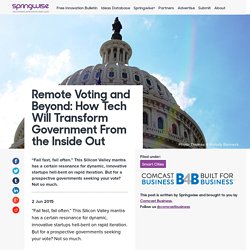
The Push To Bring Tech Efficiencies To Government Bureaucracies. John Paul FarmerCrunch Network Contributor John Paul Farmer is founder and CEO of The Innovation Project and director of Technology and Civic Innovation at Microsoft.

Paris et les villes françaises face aux défis de la «smart city» La «smart city» ou «ville intelligente», c’est l’expression à la mode attendue comme le remède à tous les maux de la ville moderne.

Les quatre piliers et les dix tendances de la smart city. On parle beaucoup de smart city ou de smart cités.
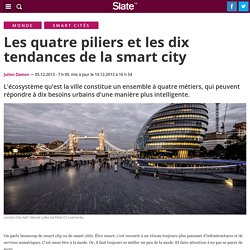
Être smart, c’est recourir à un réseau toujours plus puissant d’infrastructures et de services numériques. C’est aussi être à la mode. Or, il faut toujours se méfier un peu de la mode. Et faire attention à ne pas se payer de mots. Smart Cities. Efficace, innovante, participative : comment rendre la ville plus intelligente ? A l’origine de ce rapport, un double constat : la nécessité de freiner l’accroissement des dépenses à l’échelle locale dans un contexte de disette budgétaire et la prise en compte du thème des «villes intelligentes » comme nouvelle grille de lecture du fait urbain.
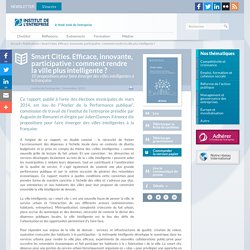
La smart city : la ville devient intelligente. Smart City Lyon. Ville intelligente. Un article de Wikipédia, l'encyclopédie libre.

L'expression « ville intelligente » est une traduction de l'expression smart city. Ce concept émergent — dont les acceptions sont mouvantes en français[1] — désigne un type de développement urbain apte à répondre à l'évolution ou l'émergence des besoins des institutions, des entreprises et des citoyens, tant sur le plan économique, social, qu'environnemental[2]. Digital-age transportation. Executive summary Incredible innovations within the transportation sector are being driven by the growing recognition that cars, once synonymous with freedom and ease of mobility, have become a victim of their own success.
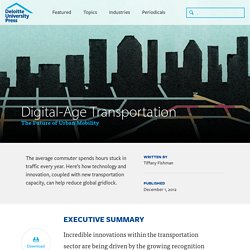
In cities around the world, congestion is undermining mobility, imposing huge costs not just on commuters or people out to run a simple errand but on society as a whole. According to the Texas Transportation Institute, the average American commuter spent 34 hours delayed in traffic in 2010, up from 14 hours in 1982. The mobile government worker – Excerpt. There’s no question that many public officials recognize the benefits of mobile.
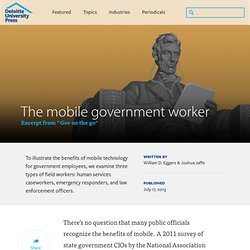
A 2011 survey of state government CIOs by the National Association of State Chief Information Officers (NASCIO) found that 58 percent of them consider mobile devices and apps either essential or a high priority for government. Public workers are even more gung-ho. As NASCIO puts it, “Even when mobile devices and apps are a priority, states struggle to keep up with state employee pressures to allow them to use personal mobile devices.”29 Workers recognize that mobile technology allows them to do their jobs better.
Gov on the go. Over the past 25 years, productivity in the private sector has risen by more than 50 percent.

Globalization, advanced manufacturing processes, and a deeper understanding of individual and organizational psychology have all contributed significantly to this growth. But the single most significant contribution to this growth has been the private sector’s ability to harness the disruptive power of technology and to use it invent better and more efficient processes. The rise of safety innovations in intelligent mobility. In the years since Karl Benz invented the modern auto-mobile in 1885, energy and safety have emerged as two long-standing themes, central to the automotive industry.1 With respect to energy, the increasingly urgent challenge has been to reduce the impact of CO2 emissions on the environment and to ameliorate resource depletion, either by using less fuel or through alternative energy sources.

We have seen the emergence of a series of “next generation” vehicles, including hybrid, plug-in hybrid, battery electric, and fuel cell vehicles, that embody the pursuit of these goals. However, to associate next-generation vehicles only with such energy-related innovations is to understate the developments underway with regard to mobility. Safety innovations are also an essential and perhaps equally rich avenue of development, important for obvious reasons, but increasingly with a vital role to play in the future direction of vehicles and the systems that may surround their use.
Player dynamics. Tech Trends 2015, Ambient computing. Possibilities abound from the tremendous growth of embedded sensors and connected devices—in the home, the enterprise, and the world at large. Translating these possibilities into business impact requires focus—purposefully bringing smarter “things” together with analytics, security, data, and integration platforms to make the disparate parts work seamlessly with each other. Ambient computing is the backdrop of sensors, devices, intelligence, and agents that can put the Internet of Things to work.
The Internet of Things (IoT) is maturing from its awkward adolescent phase. More than 15 years ago, Kevin Ashton purportedly coined the term he describes as the potential of machines and other devices to supplant humans as the primary means of collecting, processing, and interpreting the data that make up the Internet. Cut to 2015. What is the “what”?